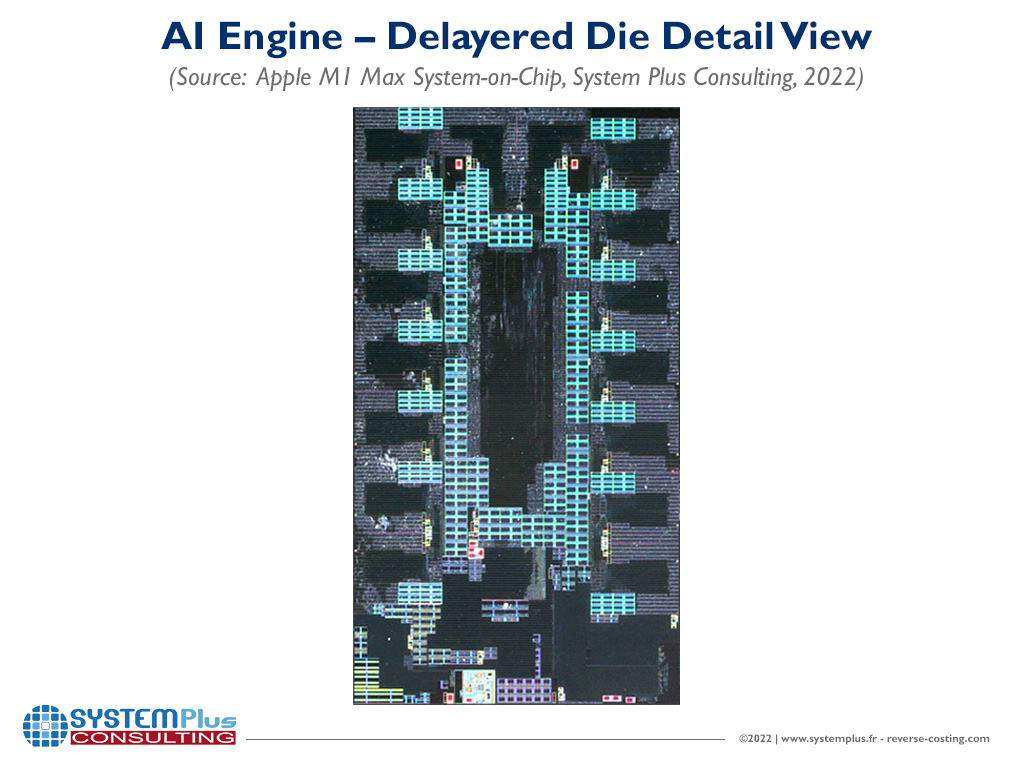This market research report was originally published at Yole Développement’s website. It is reprinted here with the permission of Yole Développement.
System Plus Consulting announces a complete analysis of the Apple-developed 10-core CPU plus 16-core GPU processor for notebooks and the Apple-developed 10-core CPU plus 32-core GPU processor for the MacBook Pro.
OUTLINE:
-
Apple M1 Max SoC : the precursor of the remarkably powerful Apple M1 Ultra SoC.
-
M1 Max is an advanced version of M1 series with bigger die size and more complex architecture than M1 Pro.
-
Apple M1 Pro SoC: the first extended version of the Apple M1 series, which takes the MacBook Pro to the next level.
-
M1 Pro SoC is manufactured by TSMC 5nm technology and assembled with LPDDR5 by SiP as the previous generation.
Lyon, France, April 28th 2022 – The reverse engineering and costing company System Plus Consulting releases today two major reverse engineering & costing analyses: Apple M1 Pro System-on-Chip and the Apple M1 Max System-on-Chip. Both studies provide valuable and accurate insights into the technical data, manufacturing cost, and selling price of the latest innovative products from leading OEM , Apple.
System Plus Consulting, the partner of Yole Développement (Yole), has developed core computing & software expertise with a dedicated team of reverse engineering & costing analysts. System Plus Consulting collaborates closely with Yole to identify the latest innovations and understand and analyze the technological choices made by the leading OEMs. Both partners combine their expertise to analyze the industry’s evolution through the technologies and the strategies of the leading companies.
Ying-Wu Liu, Technology& Cost Analyst at System Plus Consulting, asserts: “While x86 architecture is still expected to account for most PC processing, Apple’s switch to in-house processor silicon signals a major shift in this structure. Yole’s Processor Quarterly Market Monitor expects 14% of PCs to run on non-x86 processors by 2027, up from just 4% in 2020. Apple’s strategy with the M1 family and its derivatives is the main factor in this market shift, as Apple shows what is possible at the high-end of PC performance.”
In 2020, Apple published the M1 SoC to run its macOS on a proprietary design. The birth of Apple’s first processor for personal computing created a shockwave in the industry. Apple became totally independent in processor development, leaving many to speculate whether the end of Apple sockets for Intel processors had arrived. This innovation has been analyzed in-depth by System Plus Consulting‘s team: More information.
The following year, Apple presented the M1 Pro and Max SoC as the next generation of M1. Once again, Apple showed its ambition and capability with these two powerful SoCs. The M1 Pro’s die is twice the size of the M1’s die, and the M1 Max die almost four times bigger.


According to Apple, the biggest and most powerful chip for the Pro Notebook – M1 Max SoC – includes 57 billion transistors, 70% more than the M1 Pro and 3.5 times more than the M1. Regarding chip architecture, the M1 Max is equipped with a 10-core CPU, a 32-core GPU, a 16-core neural engine, and an Apple-designed media engine that boosts video processing while maximizing battery life. The chip is fabricated by TSMC on a 5nm process, which is also used to manufacture Apple’s A14 & A15 SoCs and the other M1 variants. The Apple M1 Max SoC integrates four external LPDDR5 SDRAMs into a SiP. The SoC die is flip-chip mounted onto the M1 Max SoC PCB by BGA and shares the same PCB with LPDDR5 SDRAM packages. The package also includes MLCCs and IPDs.


To reveal all the details of the Apple M1 Max SoC and the Apple M1 Pro SoC, both System Plus Consulting’s reports feature multiple analyses. These include a front-end construction analysis to reveal the most interesting features of the TSMC 5nm process, as well as package assembly and structure. In addition to a complete construction analysis using SEM cross-sections, material analyses, and delayering, System Plus Consulting’s analysts show high-resolution TEM cross-sectional images of TSMC’s 5nm features. A CT scan (3D X-ray) is also provided to reveal the layout structure of the whole chip package. Moreover, the floorplan of the SoC die is included to give a clear view of IP blocks and general chip architecture. Lastly, both reports contain a complete cost analysis and selling price estimation of Apple’s M1 Pro SoC and M1 Max SoC.


System Plus Consulting follows the evolution of semiconductor technologies closely. Each innovative component is identified and dissected by a dedicated team of experts. Make sure to gain a complete understanding of the semiconductor ecosystem and the technical choices made by the leading companies with System Plus Consulting’s analyses.
Acronyms:
- SoC: System-on-Chip
- SiP: System-In-Package
- OEM: Original Equipment Manufacturer
- GPU: Graphics Processing Unit
- PCB: Printed Circuit Board
- BGA: Ball Grid Array
- MLCC: Multilayer Ceramic Capacitors
- IPD: Integrated Passive Devices


